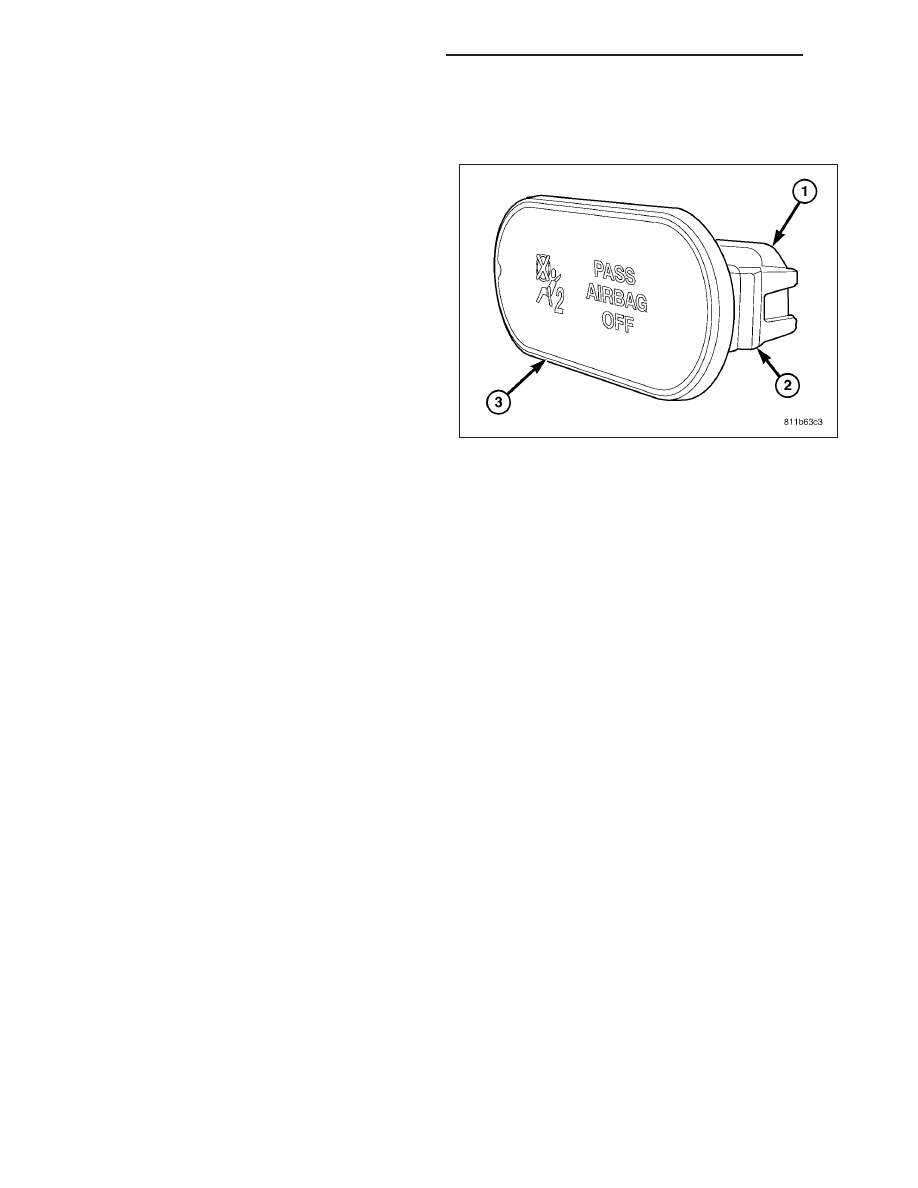Jeep Liberty KJ. Manual - part 247

PASSENGER AIRBAG ON/OFF INDICATOR
DESCRIPTION
Vehicles equipped with the Occupant Classification
System (OCS) include a passenger airbag on/off indi-
cator (3), which is located in the inboard grab handle
end cap located on the instrument panel between the
passenger airbag door and the glove box. The pas-
senger airbag on/off indicator and the grab handle are
present only in vehicles equipped with the OCS. Vehi-
cles without the OCS have only a trim bezel on the
instrument panel, instead of a grab handle.
The passenger airbag on/off indicator consists of a molded plastic housing with an integral connector receptacle (1)
at the back, an integral latch tab (2) on each side, and an oblong dark translucent outer lens. The opaque words
“PASS AIRBAG OFF” and an opaque International Control and Display Symbol icon for “Passenger Airbag Off or
Not Available” are imprinted on the back of the lens within the indicator. The dark outer lens prevents the indicator
text and icon from being clearly visible when it is not illuminated. An amber Light Emitting Diode (LED) behind the
lens causes the “PASS AIRBAG OFF” text and icon to appear silhouetted against an amber field through the trans-
lucent lens when the indicator is illuminated from behind by the LED.
The passenger airbag on/off indicator cannot be repaired or adjusted and, if faulty or damaged, the indicator unit
must be replaced.
OPERATION
In vehicles equipped with the Occupant Classification System (OCS), the passenger airbag on/off indicator gives an
indication when the passenger airbag and seat belt tensioner deployment circuits are disabled by the Airbag Control
Module (ACM). This indicator is controlled by a transistor within the ACM through a hard wired output based upon
ACM programming and electronic occupant classification messages received by the ACM over the Programmable
Communications Interface (PCI) data bus from the Occupant Classification Module (OCM).
The passenger airbag on/off indicator Light Emitting Diode (LED) is completely controlled by the ACM. The LED
receives a battery current input on the fused ignition switch output (run-start) circuit. Therefore, the LED will always
be off when the ignition switch is in any position except On or Start. The LED only illuminates when it is provided
a path to ground by the ACM transistor. The ACM will turn on the passenger airbag on/off indicator for the following
reasons:
•
Bulb Test - Each time the ignition switch is turned to the On position the passenger airbag on/off indicator is
illuminated for about six seconds.
•
Child Seat Detected (or Load Less Than Fifth Percentile Female) Occupant Classification Message -
Each time the ACM receives a message from the OCM indicating a child seat has been detected in the pas-
senger side front seat (or that the seat load is less than that of a fifth percentile female) the passenger airbag
and seat belt tensioner deployment circuits are deactivated and the passenger airbag on/off indicator will be
illuminated. The indicator remains illuminated until the ACM receives an occupant classification message indi-
cating that the passenger side front seat is empty, that the seat is occupied by a load equal to or greater than
a fifth percentile female, or until the ignition switch is turned to the Off position, whichever occurs first.
•
Load Undetermined Occupant Classification Message - Each time the ACM receives a message from the
OCM indicating that a load cannot be determined in the passenger side front seat, the passenger airbag and
seat belt tensioner deployment circuits are deactivated and the passenger airbag on/off indicator will be illu-
minated. The indicator remains illuminated until the ACM receives an occupant classification message indicat-
ing that the passenger side front seat is empty, that the seat is occupied by a load equal to or greater than a
fifth percentile female, or until the ignition switch is turned to the Off position, whichever occurs first.
8O - 294
RESTRAINTS - SERVICE INFORMATION
KJ